In the high-octane world of luxury supercars, few names shine as brightly as Horacio Pagani. This Argentine-Italian entrepreneur, engineer, and auto executive has carved out a niche in the automotive industry that’s as unique as the vehicles he creates.
With an estimated net worth of $100 million in 2024, Pagani’s journey from a small town in Argentina to the helm of one of the world’s most exclusive car manufacturers is nothing short of extraordinary. Let’s dive into the life, career, and creations of the man behind Pagani Automobili S.p.A.
The Early Years: How a Baker’s Son Became a Supercar Mogul
Horacio Pagani’s story begins in Casilda, Argentina, where he was born on November 10, 1955. The son of Luca Pagani, an Italian baker, Horacio grew up in an environment that blended Old World craftsmanship with New World ambition. From an early age, Pagani was captivated by the world of automobiles, a passion that would shape his entire life.
As a child, Pagani didn’t just dream about cars – he brought them to life in miniature. Using balsa wood, he crafted intricate models that showcased his budding talent for design and engineering. These childhood creations were so impressive that some are now displayed in the Pagani showroom, a testament to the roots of his genius.
Pagani’s formal education laid the groundwork for his future success. He studied industrial design at the National University of La Plata and later pursued mechanical engineering at the National University of Rosario. This combination of artistic vision and technical knowledge would prove invaluable in his future career.
“I remember when I was about 6 or 7 years old, that I started thinking about such things” – Horacio Pagani, on his early interest in cars
Climbing the Automotive Ladder: Pagani’s Career Journey
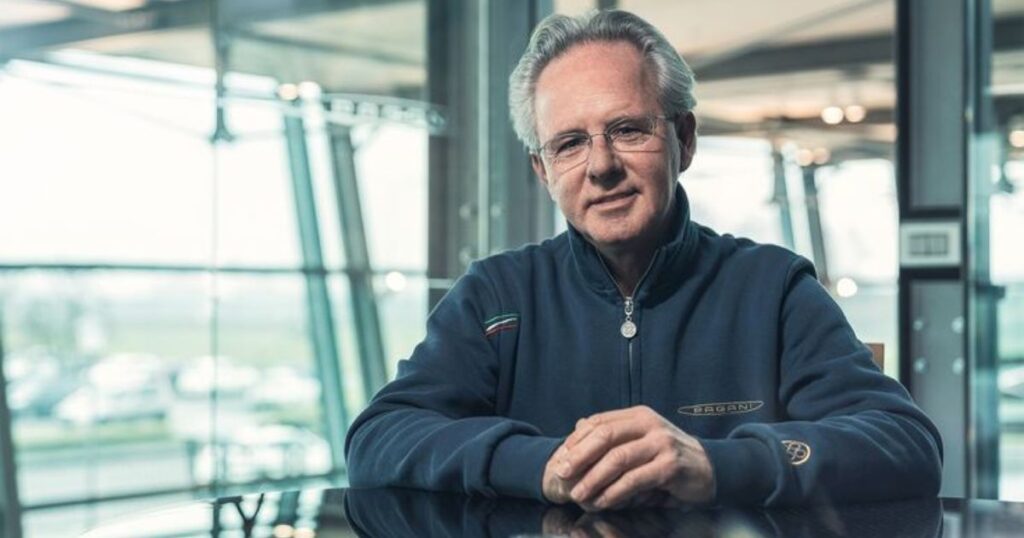
Pagani’s professional journey began in Argentina, where he opened a small 80-square-meter workshop dubbed “the factory.” Here, he took on various projects, including designing and building an F3 racer at the young age of 20. This early success fueled his ambition to move to Italy, the heartland of automotive excellence.
In Italy, Pagani’s career took off. He first worked with Renault, improving the bodies of their racing cars. This experience caught the eye of Giulio Alfieri, the head of Lamborghini’s technical division, leading to a pivotal moment in Pagani’s career.
The Lamborghini Years: Where Genius Met Opportunity
Pagani’s time at Lamborghini was transformative. Starting with basic duties, he quickly rose through the ranks, eventually becoming the company’s chief engineer. His crowning achievement at Lamborghini was the development of the Countach Evoluzione in 1985.
The Countach Evoluzione was revolutionary. It was one of the first cars to extensively use composite materials, showcasing Pagani’s innovative approach to automotive design and engineering. This project laid the foundation for his future work with carbon fiber, a material that would become synonymous with Pagani cars.
Love in the Fast Lane: Pagani’s Marriage and Family Life
Behind every great man is a great woman, and for Horacio Pagani, that woman is Cristina Salvi. Their partnership extends beyond marriage – Cristina has been instrumental in Pagani Automobili’s success, particularly in marketing and communication.
The Paganis have two children:
- Lia (daughter)
- Christopher (son)
Both children have shown interest in the family business, contributing to various aspects of Pagani Automobili’s operations. This family involvement ensures that the Pagani legacy will continue for generations to come.
From Employee to Entrepreneur: Pagani’s Rise in the Automobile Industry
In 1987, Pagani took a significant risk by borrowing money to purchase his own autoclave, allowing him to produce carbon parts for the Countach Evoluzione. This move set the stage for his departure from Lamborghini in 1991 and the founding of Modena Design, a consulting firm specializing in composite materials for racing cars.
Pagani’s expertise in carbon fiber composites quickly gained recognition in the automotive world. His innovative use of these materials would become a hallmark of his future designs, setting Pagani cars apart from their competitors.
Pagani Automobili S.p.A: Birth of a Supercar Legend
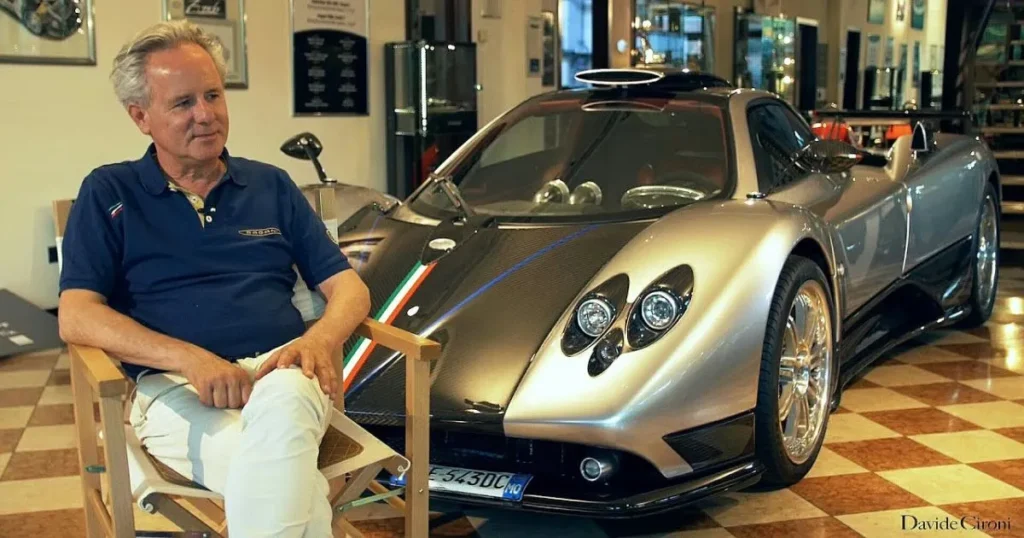
In 1992, Horacio Pagani took the biggest leap of his career by founding Pagani Automobili S.p.A. The company’s first car, the Zonda, debuted in 1999 and immediately caused a sensation in the automotive world.
The Zonda’s key features included:
- A powerful Mercedes-AMG V12 engine
- Extensive use of carbon fiber in its construction
- A design that blended aerodynamic efficiency with aesthetic beauty
The success of the Zonda paved the way for future models, including the Huayra and the Utopia. Each new Pagani car pushed the boundaries of automotive technology and design, cementing the company’s reputation as a leader in the supercar market.
The $100 Million Question: Breaking Down Pagani’s Net Worth
As of 2024, Horacio Pagani’s net worth is estimated at $100 million. This impressive figure is the result of several factors:
- Car Sales: Pagani automobiles command astronomical prices. For example, the Zonda HP Barchetta sold for 15 million euros.
- Company Value: As the founder and CEO of Pagani Automobili, Horacio owns a significant stake in the company.
- Consulting Work: Pagani’s expertise in composite materials is highly valued in the automotive industry.
- Investments: Like many successful entrepreneurs, Pagani likely has diversified investments.
It’s worth noting that Pagani cars often appreciate in value. Some models have fetched $10-20 million at auction, contributing to the brand’s prestige and Pagani’s personal wealth.
Read Also: Benson Boone Net Worth 2024 – Income, Salary, Career, Age, Bio
Beyond Business: Pagani’s Personal Car Collection
Horacio Pagani’s passion for automobiles extends beyond his own creations. He owns a remarkable collection of approximately 120 cars, showcasing his appreciation for automotive history and design.
Some notable cars in Pagani’s collection include:
- Pagani Huayra BC Roadster: His own creation, valued at around $4 million
- Ferrari 365 GTB/4 “Daytona”: An iconic Ferrari produced from 1968 to 1973
- Lamborghini Miura: One of the most sought-after classic supercars
Pagani’s collection reflects his diverse tastes and deep appreciation for automotive engineering across different eras and manufacturers.
Two-Wheeled Treasures: Horacio Pagani’s Motorcycle Passion
While cars are his primary focus, Pagani also has a notable motorcycle collection. Some of the impressive bikes in his garage include:
- Ducati Panigale V4: A high-performance sportbike with a 1,103cc V4 engine
- MV Agusta F4 Claudio: A limited edition bike with a 998cc four-cylinder engine
- Bimota Tesi H2: An innovative bike with a hub-centered steering system
Pagani’s interest in motorcycles showcases his broader appreciation for all forms of motorized transport and engineering excellence.
“The bike is a bike, but to me, it is a timeless object” – Horacio Pagani
Home Sweet Home: Where a Supercar Visionary Lays His Head
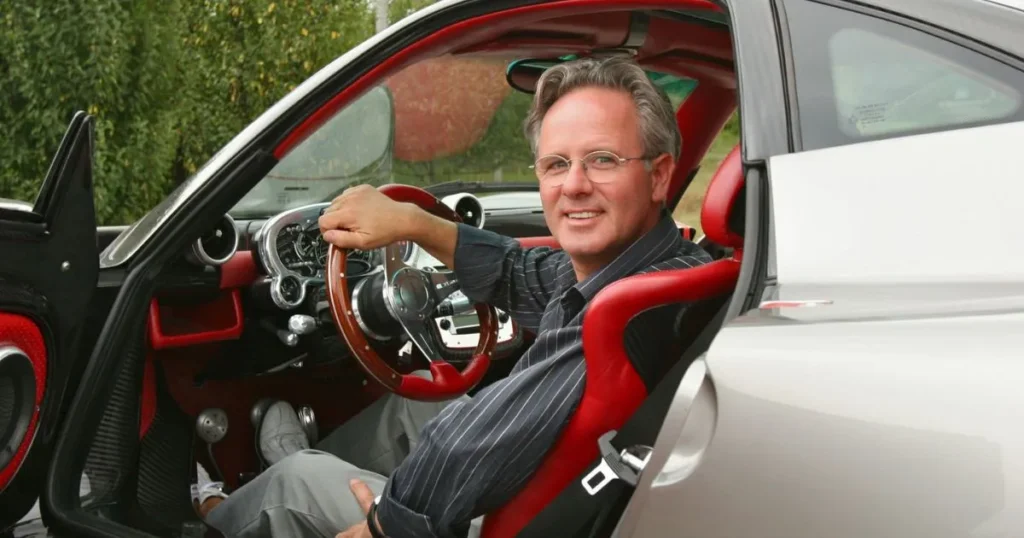
Horacio Pagani’s success is reflected in his living arrangements. He resides in a luxurious villa on the outskirts of Modena, Italy, close to the headquarters of Pagani Automobili S.p.A. The villa is said to include:
- A large garden
- A swimming pool
- A custom-designed home theater
- A garage that can accommodate six supercars
In addition to his Italian residence, Pagani is believed to own property in Argentina, maintaining a connection to his roots.
The Pagani Philosophy: Blending Art and Engineering
What sets Pagani apart in the competitive world of supercars is his unique philosophy that blends artistry with cutting-edge engineering. This approach is evident in every Pagani automobile, where form and function are given equal importance.
Key aspects of the Pagani philosophy include:
- Attention to Detail: Every component of a Pagani car is meticulously designed and crafted.
- Use of Advanced Materials: Pagani’s expertise in carbon fiber and composite materials is a cornerstone of his designs.
- Performance without Compromise: Pagani cars are not just beautiful; they’re also incredibly powerful and efficient.
- Limited Production: By producing a small number of cars each year, Pagani ensures exclusivity and maintains high quality standards.
This philosophy has earned Pagani a devoted following among car enthusiasts and collectors worldwide.
The Art of Craftsmanship: Pagani’s Attention to Detail
One of the hallmarks of Pagani automobiles is the extraordinary attention to detail that goes into every vehicle. This obsession with perfection is a direct reflection of Horacio Pagani’s personal philosophy and approach to craftsmanship.
Consider these remarkable facts about Pagani’s production process:
- Titanium Bolts: Each Pagani car features over 1,400 titanium bolts, each etched with the Pagani logo. These bolts alone cost over $80,000 per car.
- Hand-Crafted Interiors: The leather interiors of Pagani cars are meticulously crafted by a team of skilled artisans.
- Bespoke Components: Many parts of a Pagani car are custom-made for that specific vehicle, ensuring a level of uniqueness unmatched in the industry.
This level of detail and customization is part of what justifies the multi-million dollar price tags of Pagani automobiles. It’s not just about buying a car; it’s about owning a piece of automotive art.
The Pagani Design Process: Where Art Meets Science
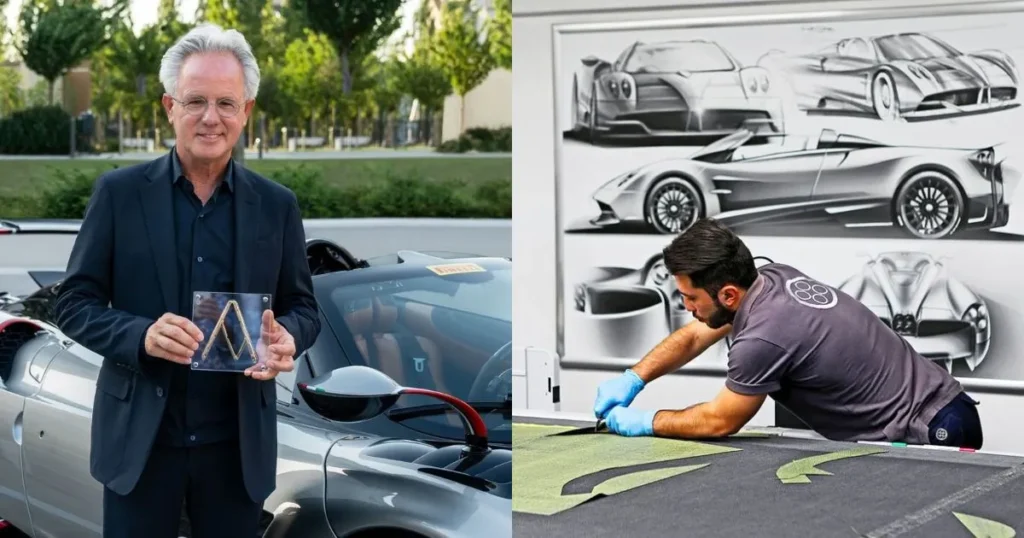
One of the most intriguing aspects of Horacio Pagani’s work is his unique approach to car design. Unlike many modern automotive designers who rely heavily on computer-aided design (CAD) software, Pagani still begins his creative process with pencil and paper.
Here’s a glimpse into Pagani’s design process:
- Initial Sketches: Pagani starts with hand-drawn sketches, allowing for a more organic and fluid design process.
- Clay Modeling: From these sketches, full-scale clay models are created, a traditional technique that allows designers to visualize the car in three dimensions.
- Digital Refinement: Only after the physical model is perfected does the design move to computer software for fine-tuning and engineering analysis.
- Wind Tunnel Testing: Extensive aerodynamic testing ensures that the car’s beauty doesn’t come at the cost of performance.
This blend of old-school craftsmanship and cutting-edge technology is emblematic of Pagani’s philosophy, marrying the artisanal with the high-tech.
The Zonda: A Closer Look at Pagani’s Breakthrough Model
The Pagani Zonda, first introduced in 1999, was the car that put Horacio Pagani on the map. Let’s take a closer look at what made this car so special:
| Feature | Description |
| Engine | 7.3-liter Mercedes-AMG V12 |
| Power | Up to 800 horsepower in later models |
| Body | Carbon fiber monocoque |
| Weight | Approximately 1,250 kg |
| Top Speed | Over 350 km/h (217 mph) |
| Production | Less than 150 units across all variants |
The Zonda’s success lay not just in its impressive performance figures, but in its unique design and the way it showcased Pagani’s expertise in carbon fiber technology. The car’s distinctive teardrop-shaped cabin and quad tailpipe arrangement became iconic features that set it apart from other supercars of its era.
Read Also: Ilan Tobianah Net Worth Age, Wife, Wikipedia, Instagram 2024
Pagani and Sustainability: Balancing Performance with Responsibility
As the automotive industry moves towards more sustainable practices, Horacio Pagani has been thoughtful about how to incorporate environmental considerations into his high-performance vehicles. While Pagani cars are not known for their fuel efficiency, the company has taken steps to reduce its environmental impact:
- Efficient Use of Materials: Pagani’s expertise in carbon fiber allows for the creation of incredibly strong, lightweight structures, improving overall vehicle efficiency.
- Longevity: Pagani cars are built to last, with many owners treating them as long-term investments rather than disposable commodities.
- Exploration of Alternative Powertrains: While not yet implemented, Pagani has expressed interest in exploring hybrid technologies for future models.
“We are looking at electrification, but we want to do it in a way that doesn’t compromise the driving experience our customers expect.” – Horacio Pagani
The Huayra: Evolving the Pagani Formula
Following the success of the Zonda, Horacio Pagani faced the challenge of creating a worthy successor. The result was the Huayra, named after Huayra-tata, a god of wind in Incan mythology. The Huayra showcased Pagani’s continued innovation:
- Active Aerodynamics: The Huayra features four independently operating flaps that adjust in real-time to optimize downforce and reduce drag.
- Central Monocoque: The car’s central structure is made from carbo-titanium, a Pagani-developed material combining carbon fiber and titanium for incredible strength and lightness.
- Bespoke AMG Engine: A twin-turbocharged V12 engine developed specifically for the Huayra by Mercedes-AMG.
The Huayra BC, a track-focused variant named after Pagani’s first customer Benny Caiola, further pushed the boundaries of what was possible in a road-legal supercar.
Pagani’s Influence on the Supercar Industry
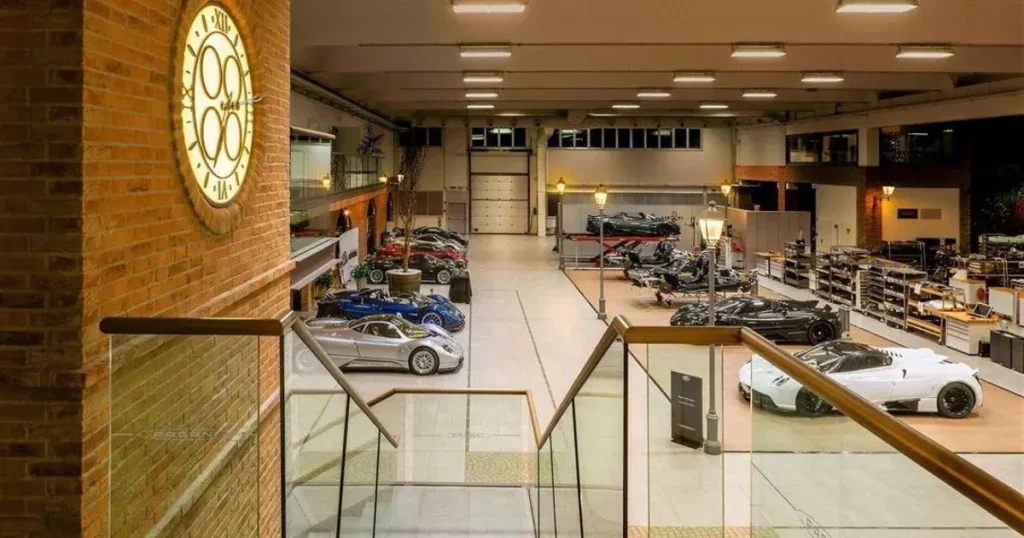
Horacio Pagani’s work has had a significant impact on the broader supercar industry:
- Materials Technology: Pagani’s use of advanced composites has influenced other manufacturers to explore similar technologies.
- Artisanal Approach: The success of Pagani’s highly personalized, low-volume production model has encouraged other boutique supercar manufacturers.
- Design Philosophy: Pagani’s emphasis on combining dramatic styling with aerodynamic efficiency has become increasingly common in the supercar world.
The Pagani Factory: A Modern Atelier
The Pagani factory in San Cesario sul Panaro, near Modena, is unlike any other automotive production facility. More akin to an artist’s studio than a traditional car plant, it reflects Horacio Pagani’s unique approach to car making.
Key features of the Pagani factory include:
- Open Layout: The factory floor is open and airy, more reminiscent of a high-end workshop than an industrial facility.
- Craftsman Stations: Individual workstations allow skilled artisans to focus on their specific tasks without a traditional assembly line.
- In-House Carbon Fiber Production: Pagani produces its own carbon fiber components on-site, ensuring quality control and allowing for rapid prototyping.
- Art Gallery Atmosphere: The factory doubles as a showroom, with classic cars and art pieces displayed throughout.
This environment fosters creativity and attention to detail, key elements of the Pagani brand.
Pagani’s Collaborations: Partnerships that Drive Innovation
While Pagani Automobili is known for its independence, Horacio Pagani has fostered several key partnerships that have been crucial to the company’s success:
- Mercedes-AMG: Provides the powerful V12 engines that are a hallmark of Pagani cars.
- Pirelli: Develops bespoke tires tailored to each Pagani model’s unique characteristics.
- Brembo: Supplies the high-performance braking systems essential for Pagani’s extreme performance.
- Sonus faber: Creates custom audio systems that match the cars’ exquisite interiors.
These collaborations allow Pagani to focus on its core competencies while leveraging the expertise of industry leaders in specific areas.
The Future of Pagani: What’s Next for Horacio and His Company?
As Horacio Pagani looks to the future, several exciting developments are on the horizon:
- New Models: The recently unveiled Utopia continues Pagani’s tradition of pushing boundaries in design and engineering.
- Expanded Customization: Pagani is exploring ways to offer even more personalization options to its discerning clientele.
- Technological Advancements: The company continues to invest in research and development, particularly in the areas of materials science and aerodynamics.
The Legacy of Horacio Pagani
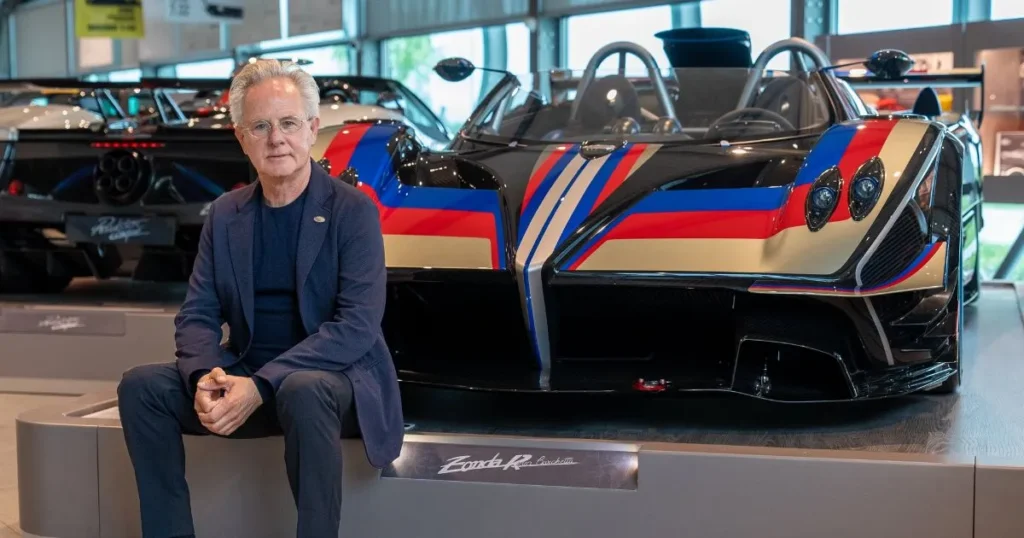
Horacio Pagani’s journey from a young car enthusiast in Argentina to a supercar mogul with a $100 million net worth is a testament to the power of passion, innovation, and perseverance. His contributions to the automotive industry extend beyond the cars that bear his name:
- He has pushed the boundaries of materials science in automobile manufacturing.
- Pagani has shown that small, focused companies can compete with larger, established automakers.
- His designs have influenced the entire supercar industry, raising the bar for performance and aesthetics.
As we look to the future, it’s clear that Horacio Pagani’s impact on the automotive world will be felt for generations to come. His story serves as an inspiration to aspiring engineers, designers, and entrepreneurs around the world.
Read Also: Justin Saliman Net Worth 2024 – Wife, Age, Height, Professional Life and more
FAQ’s
Who is Horacio Pagani net worth?
Horacio Pagani’s net worth is estimated at $100 million as of 2024. This wealth comes from his successful supercar company, Pagani Automobili S.p.A.
What language does Horacio Pagani speak?
Horacio Pagani speaks Italian and Spanish fluently. He learned Italian after moving from Argentina to Italy to pursue his automotive career.
How did Horacio Pagani make his money?
Pagani made his money by founding and running Pagani Automobili S.p.A. His company produces ultra-luxury, high-performance supercars that sell for millions of dollars each.
Why is Pagani so famous?
Pagani is famous for creating some of the world’s most exclusive and innovative supercars. His attention to detail, use of advanced materials, and blend of art and engineering set Pagani cars apart in the automotive world.
Conclusion
Horacio Pagani’s rise from a baker’s son in Argentina to a $100 million supercar visionary is a remarkable tale of talent, determination, and innovation. Through his work at Lamborghini, the founding of Pagani Automobili S.p.A., and the creation of some of the world’s most exclusive automobiles, Pagani has left an indelible mark on the automotive industry.
His journey reminds us that with passion, skill, and a willingness to take risks, it’s possible to turn dreams into reality – even in the highly competitive world of luxury automobiles. As Pagani continues to innovate and create, we can only imagine what incredible machines will emerge from his workshop in the years to come.
Whether you’re a car enthusiast, an aspiring entrepreneur, or simply someone who appreciates the fusion of art and engineering, Horacio Pagani’s story offers valuable lessons and inspiration. It shows us that with vision, dedication, and a touch of artistic flair, it’s possible to create something truly extraordinary.
What’s your favorite Pagani model? Do you think Horacio Pagani’s approach to car design will continue to influence the industry in the coming years? Share your thoughts and join the conversation about this remarkable figure in automotive history.

Hello, I’m Amelia Eva a dynamic author at TrendOxygen.com, specializing in Tech, Lifestyle, Business, Entertainment, and Sports. Passionate about uncovering the latest trends, my articles offer a broad range of topics, delivering insightful and captivating content for readers.
With an exceptional ability to simplify complex concepts, I make my writing approachable for everyone. Follow me on TrendOxygen.com for fresh insights and the latest updates on what’s trending in the world of technology, lifestyle, and beyond.


![Horacio Pagani Net Worth 2024 [$100 Million, Wife, Son] Horacio Pagani](https://trendoxygen.com/wp-content/uploads/2024/09/horacio-pagani-1024x538.webp)